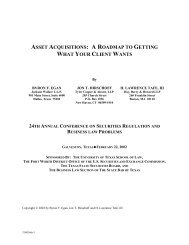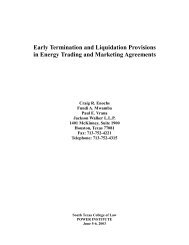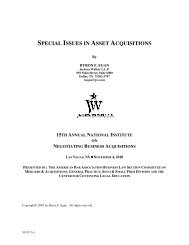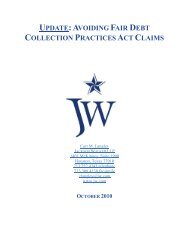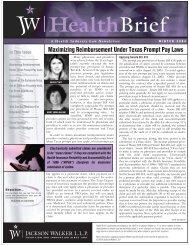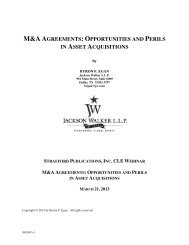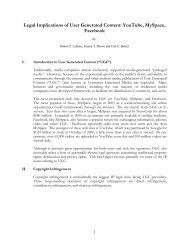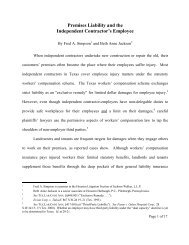Download Article - Jackson Walker LLP
Download Article - Jackson Walker LLP
Download Article - Jackson Walker LLP
Create successful ePaper yourself
Turn your PDF publications into a flip-book with our unique Google optimized e-Paper software.
In the energy commodity industry, the term “master agreement” means an agreementwith terms and conditions that will apply to multiple transactions, each evidenced by atransaction confirmation. The NAESB Base Contract for Sale and Purchase of Natural Gas(“NAESB”) 1 is the master agreement most commonly used to document natural gas (“Gas”)transactions, the EEI Master Power Purchase and Sale Agreement (the “EEI”) 2 is commonlyused to document power transactions, the Coal Trading Association’s Master Coal Purchase andSale Agreement (the “CTA”) 3 is commonly used to document coal transactions, and the ISDAMaster Agreement (“ISDA”) is commonly used to document derivative transactions. The ISDAalso is used to document Gas, power and coal transactions through the use of the Gas Annex, thePower Annex and the Coal Annex. 4Parties may have NAESB, EEI, CTA and/or ISDA agreements, and multiple versions ofeach, outstanding with the same counterparty at the same time. Minor differences between suchtrading agreements could create risk for a party transacting under different agreements. Riskalso may arise when parties enter into different versions of the same trading agreement. Partiescan mitigate such risks by modifying the concepts contained in trading contracts to promoteconsistency across agreements. However, parties first must be aware of the numerous tradingrisks created by such differences. 5 The purpose of this paper is to analyze differences betweenthe NAESB, EEI, ISDA and CTA (and between different versions thereof) that could createtrading risk due to inconsistent terms among such agreements. 61 For purposes herein, (i) all citations and references to the “2002 NAESB” shall be to the version published by theNorth American Energy Standards Board, Inc. on April 19, 2002; (ii) all citations and references to the “2006NAESB” shall be to the version published by the North American Energy Standards Board, Inc. on September 5,2006; and (iii) all citations and references to the “NAESB” shall be to both the 2002 NAESB and 2006 NAESB,collectively.2 For purposes herein, all citations and references to the “EEI” shall be to the version published by the EdisonElectric Institute and National Energy Marketers Association, version 2.1 (modified March 3, 2000).3 For purposes herein, all citations and references to the “CTA” shall be to the 2006 Master Coal Purchase and SaleAgreement approved and published by the Coal Trading Association in December, 2006.4 For purposes herein, (i) all citations and references to the “ISDA Master Agreement” or the “1992 ISDA” shall beto 1992 Master Agreement (Multicurrency-Cross Border) published by the International Swaps and DerivativesAssociation, Inc. (“ISDA”); (ii) all citations and references to the “2002 ISDA” shall be to the 2002 MasterAgreement (Multicurrency-Cross Border) published by ISDA; (iii) all citations and references to the “ISDASchedule” shall be to the ISDA Schedule to the Master Agreement, which forms part of the ISDA MasterAgreement; (iv) all citations and references to the “ISDA CSA” shall be to the 1994 Credit Support Annexpublished by ISDA; (v) all citations and references to the “Gas Annex” shall be to the ISDA North American GasAnnex published by ISDA in 2004; (vi) all citations and references to the “Power Annex” shall be to the NorthAmerican Power Annex published by ISDA in 2003; (vii) all citations and references to the “Coal Annex” shall beto the ISDA Global Physical Coal Annex published by ISDA on April 18, 2007; and (viii) all citations andreferences to the “ISDA” shall be to the collective ISDA Agreement, including the ISDA Master Agreement(whether the 1992 or 2002 form), the ISDA Schedule, the ISDA CSA, and any other Annexes or documents theparties may elect to incorporate thereunder.5 For example, to avoid gaps between various energy contracts, parties may wish to amend the terms of form tradingagreements by incorporating special provisions or additional elections that are consistent throughout such party’senergy transactions.F6 Though differences exist between the various credit documents associated with the NAESB, EEI, ISDA and CTA(such as the NAESB’s Credit Support Addendum (the “NAESB CSA”), the EEI’s Collateral Annex, and the ISDACSA), an analysis of the distinctions between such credit documents is beyond the scope of this paper.1




